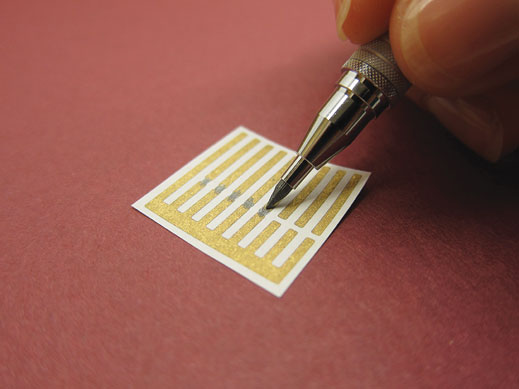A new fabrication method created by MIT chemists—one as simple as drawing a line on a sheet of paper—may lead to a powerful new way to detect harmful gases in the environment. Gas-detecting sensors can be inscribed on any paper surface with a pencil in which a compressed powder of carbon nanotubes serves as the lead.

The sensor detects minute amounts of ammonia gas, an industrial hazard, but could be adapted for nearly any type of gas, says chemistry professor Timothy Swager, who led the research team.
Carbon nanotubes are one-atom-thick sheets of carbon rolled into cylinders that allow electrons to flow without hindrance. Such materials have been shown to be effective sensors for many gases, which bind to the nanotubes and impede electron flow. However, manufacturing these sensors can be hazardous.
Inspired by pencils on her desk, Katherine Mirica, a postdoc in Swager’s lab, had the idea of compressing carbon nanotubes into a graphite-like material. To create sensors, the researchers use that material in a regular mechanical pencil to draw a line of carbon nanotubes on paper imprinted with small electrodes made of gold. They then apply an electrical current and measure the current as it flows through the carbon nanotube strip, which acts as a resistor. If the current is altered, it means gas has bound to the nanotubes.
The researchers are now tailoring sensors to detect a wide range of gases, including ethylene, which would be useful for monitoring the ripeness of fruit as it is shipped and stored.
Keep Reading
Most Popular
Large language models can do jaw-dropping things. But nobody knows exactly why.
And that's a problem. Figuring it out is one of the biggest scientific puzzles of our time and a crucial step towards controlling more powerful future models.
How scientists traced a mysterious covid case back to six toilets
When wastewater surveillance turns into a hunt for a single infected individual, the ethics get tricky.
The problem with plug-in hybrids? Their drivers.
Plug-in hybrids are often sold as a transition to EVs, but new data from Europe shows we’re still underestimating the emissions they produce.
Stay connected
Get the latest updates from
MIT Technology Review
Discover special offers, top stories, upcoming events, and more.